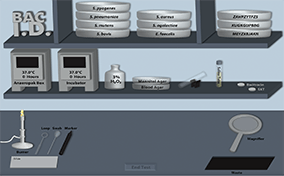What is the purpose of a catalase test?
The catalase test measures the presence of the catalase enzyme. The test differentiates for bacteria that have the enzyme, such as Staphylococci, and those that do not, such as Streptococci. The test consists of exposing the bacteria sample to a 3% hydrogen peroxide solution. Bubbles from the enzyme breaking down the hydrogen peroxide into water and oxygen gas are positive indicators of the presence of catalase.
What are capnophiles?
Capnophiles are microorganisms capable of surviving in high concentrations of carbon dioxide.
What is purpose of the blood agar test?
Sheep blood agar (SBA) is a general nutritious medium that supports the growth of many bacteria isolated in the clinical microbiology laboratory. This medium, however, will not support the growth of some fastidious bacteria like Haemophilus spp. SBA is differential, allowing for the differentiation of bacteria based on the ability to hemolyze the red blood cells.
What are the three main hemolytic reaction results?
Some bacteria produce hemolysins that totally lyse the red blood cells. The colonies of these bacteria produce a clear zone or halo around the colony. This type of hemolysis is called beta hemolysis. The diameter of the zone of hemolysis varies among different species. Other bacteria species produce hemolysins that partially lyse the red blood cells, producing a green halo around colonies. This is referred to as alpha hemolysis. Some bacteria do not produce any hemolysis and are called nonhemolytic.
How are Streptococci classified?
The major scheme used to classify Streptococci is based on their ability to hemolyze red blood cells. Bacteria that partially hemolyze red blood cells are called alpha-hemolytic. Pneumococci and some viridans group are examples of alpha-hemolytic organisms. Other bacteria do not hemolyze red blood cells and are called nonhemolytic. Beta-hemolytic bacteria that completely lyse red blood cells are further divided into Lancefield groups A–H.
What is the purpose of the mannitol salt agar (MSA) test?
MSA is both a selective and differential growth medium. The medium has three major components: sodium chloride (salt), mannitol (carbohydrate), and phenol red (an indicator). The salt acts selectively by inhibiting the growth of most bacteria. It differentiates by enhancing the growth of gram-positive bacteria such as Staphylococci. The mannitol acts as a differentiator, providing a medium for bacteria that ferment the carbohydrate. This fermentation produces an acid that is detected by the phenol red indicator and presents a yellow color.
What is the purpose of the bile esculin agar (BEA) slant tube test?
The BEA test is used to distinguish Enterococcus microorganisms from Streptococcus. Streptococci are generally not capable of growth in a bile containing medium and are not capable of hydrolyzing esculin to glucose and esculetin. Enterococci grow in this medium and produce esculetin that combines with ferric ions in the medium to produce a black-colored complex.
What is the purpose of a bacitracin disk test?
The growth of Lancefield group A Streptococci are generally inhibited in the presence of small amounts of bacitracin. Most other beta-hemolytic Streptococci exposed to bacitracin are not growth-inhibited, with the exception of a few group C, F, and G Streptococci.
What is the purpose of a sulfamethoxazole-trimethoprim (SXT) disk test?
While group A beta-hemolytic organisms are susceptible to bacitracin, most are not susceptible to SXT. Most group B beta-hemolytic bacteria are resistant to both bacitracin and SXT. Some members of groups C, F, and G beta-hemolytic Streptococci are susceptible to both bacitracin and SXT.
 Bacteria come in many types. A number of different laboratory tests exist that culture and identify the bacteria. Can you select the correct test to identify common bacteria? Grab the medium of your choice and start identifying the laboratory samples.
Bacteria come in many types. A number of different laboratory tests exist that culture and identify the bacteria. Can you select the correct test to identify common bacteria? Grab the medium of your choice and start identifying the laboratory samples.

